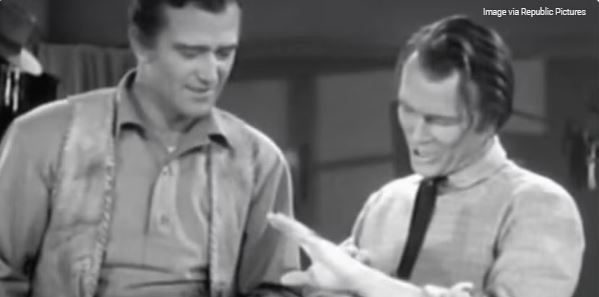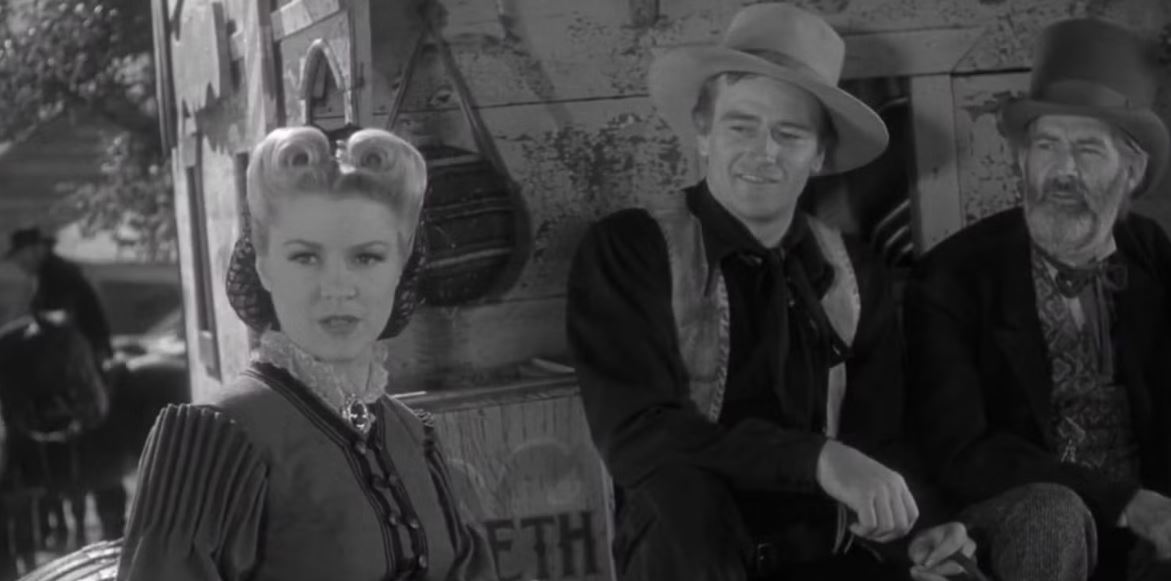Considering his wise breadth of Westerns over the span of about 50 years, one might think that John Wayne worked with just about everybody, and, for the most part, you’d be right. But there’s one Western star whom the Duke, quite surprisingly, only ever worked with once: Roy Rogers. Rogers was known as “the King of the Cowboys” in the same vein that Elvis Presley was the King of Rock & Roll, and so it’s surprising that the two only ever appeared in one film together: 1940’s Dark Command. If you haven’t heard of this black-and-white rural crime drama, then consider this your sign to check out this feature.
‘Dark Command’ United John Wayne and Roy Rogers For the First and Only Time

Dark Command has often been described as a “crime Western,” and it certainly fits the bill. Set both before and during the American Civil War, the flick highlights two warring factions of pro-Union or pro-Confederacy sympathizers who duke it out in their Kansas hometown. The film has largely been forgotten as far as both John Wayne and Roy Rogers’ greater filmographies are concerned, but at the time, the flick was one of the few Westerns nominated for multiple Oscars. It’s fun to see this pair share the screen together in any capacity, especially in a picture like this. At the beginning of Dark Command, Wayne’s Bob Stetson and Rogers’ Fletch McCloud were friends, but as the film progresses — and tensions rise between Northern and Southern sympathizers — all of that is subject to change, and then to change back again.
For two heroes of the horse opera who stand remarkably tall on their own already, the Duke and Rogers make a great pair here. No matter if they’re on the same side or not (which shifts throughout the picture), there’s a clear chemistry between these Old Hollywood heavies that simply works. No, Rogers doesn’t burst into song, but there’s enough action, drama, and suspense in place of any cowboy musical numbers. Of course, co-stars Claire Trevor, George “Gabby” Hayes, and Walter Pidgeon are just as vital to Dark Command’s success as Wayne or Rogers are, but if you’re a fan of either Western star, this drama is certainly enough to whet the appetite. It’s only a shame that these two never worked on another picture together again.
Based loosely on the historical Lawrence Massacre that occurred in 1863 — Pidgeon’s Will Cantrell is clearly based on the similarly-named William Quantrill, who led the raid — Dark Command ends with a climactic battle in the heart of Kansas. As the city erupts into flames and the Confederate guerrillas invade, only Wayne’s Bob Stetson can rally the people of Lawrence to defend themselves and fight for what’s right. It’s a powerful way to end this Western B-picture, one that works because both Wayne and Pidgeon are strong leading men. No, Roy Rogers isn’t one of the leads here (this was many years before The Roy Rogers Show), but his part in the story is vital to Wayne’s success.
Roy Rogers Isn’t His Usual Cowboy Self Here — But He Finds Trouble Anyhow

When Roy Rogers first comes to mind, one quickly pictures a singing cowboy in the style of Gene Autry. Indeed, it was only after Autry exited his deal with Republic Pictures — who also produced John Wayne’s Three Musketeers franchise — that Rogers took over his next motion picture, Under Western Stars, for himself. However, here in Dark Command, there are no trademark Rogers tunes, nor does he even pick up a guitar. This may come as a surprise since, according to the Country Music Hall of Fame, Rogers was the biggest Western star of the mid-1940s, largely due to his “King of the Cowboys” persona. This was true until The Roy Rogers Show took off. Of course, Dark Command helped thrust the cowboy legend into the spotlight, just without his usual musical flare.
In Dark Command, Roy Rogers’ Fletch character is a more serious role, playing a young boy who struggles to learn what it means to be a man, and that there are consequences that come with brandishing oneself with a gun. His youthful vigor and desire to fight for what he believes in is admirable, but it’s his willingness to admit that he was wrong (thus forsaking his poor choices) that truly stands out. By the end, we can only wonder where Rogers’ Fletch and Wayne’s Bob Stetson will ultimately end up (probably Texas), but there’s no doubt that their future is a far brighter one than the folks they left behind.
Dark Command is available to rent on Amazon in the U.S.
